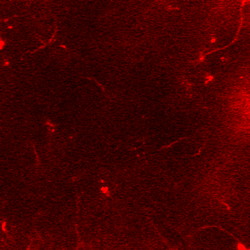Press Release: Researchers Discover How Inhibitory Neurons Behave During Critical Periods of Learning
Contact: Jocelyn Duffy / 412-268-9982 / jhduffy@andrew.cmu.edu
 PITTSBURGH—We've all heard the saying "you can't teach an old dog new tricks." Now neuroscientists are beginning to explain the science behind the adage.
PITTSBURGH—We've all heard the saying "you can't teach an old dog new tricks." Now neuroscientists are beginning to explain the science behind the adage.
For years, neuroscientists have struggled to understand how the microcircuitry of the brain makes learning easier for the young, and more difficult for the old. New findings published in the journal Nature by Carnegie Mellon University, the University of California, Los Angeles and the University of California, Irvine show how one component of the brain's circuitry — inhibitory neurons — behave during critical periods of learning. The article is available as an advance online publication at http://dx.doi.org/10.1038/nature12485.
The brain is made up of two types of cells — inhibitory and excitatory neurons. Networks of these two kinds of neurons are responsible for processing sensory information like images, sounds and smells, and for cognitive functioning. About 80 percent of neurons are excitatory. Traditional scientific tools only allowed scientists to study the excitatory neurons.
"We knew from previous studies that excitatory cells propagate information. We also knew that inhibitory neurons played a critical role in setting up heightened plasticity in the young, but ideas about what exactly those cells were doing were controversial. Since we couldn't study the cells, we could only hypothesize how they were behaving during critical learning periods," said Sandra J. Kuhlman, assistant professor of biological sciences at Carnegie Mellon and member of the joint Carnegie Mellon/University of Pittsburgh Center for the Neural Basis of Cognition.
The prevailing theory on inhibitory neurons was that, as they mature, they reach an increased level of activity that fosters optimal periods of learning. But as the brain ages into adulthood and the inhibitory neurons continue to mature, they become even stronger to the point where they impede learning.
Newly developed genetic and imaging technologies are now allowing researchers to visualize inhibitory neurons in the brain and record their activity in response to a variety of stimuli. As a postdoctoral student at UCLA in the laboratory of Associate Professor of Neurobiology Joshua T. Trachtenberg, Kuhlman and her colleagues used these new techniques to record the activity of inhibitory neurons during critical learning periods. They found that, during heightened periods of learning, the inhibitory neurons didn't fire more as had been expected. They fired much less frequently — up to half as often.
"When you're young you haven't experienced much, so your brain needs to be a sponge that soaks up all types of information. It seems that the brain turns off the inhibitory cells in order to allow this to happen," Kuhlman said. "As adults we've already learned a great number of things, so our brains don't necessarily need to soak up every piece of information. This doesn't mean that adults can't learn, it just means when they learn, their neurons need to behave differently."
In addition to Kuhlman and Trachtenberg, Nicholas D. Olivas, Taruna Ikrar and Xiangmin Xu of UC Irvine, and Elaine Tring of UCLA contributed to this study.
The study was funded by the National Eye Institute (EY016052), the National Institute of Neurological Disorders and Stroke (NS078434) and a NARSAD Young Investigator Grant.
With a solid foundation of research excellence in neuroscience, psychology and computational science, Carnegie Mellon is a world leader in brain and behavioral sciences. For more information of brain, mind and learning research at Carnegie Mellon, visit www.cmu.edu/brain.
###
New techniques are allowing researchers to visualize inhibitory neurons (red), pictured above.